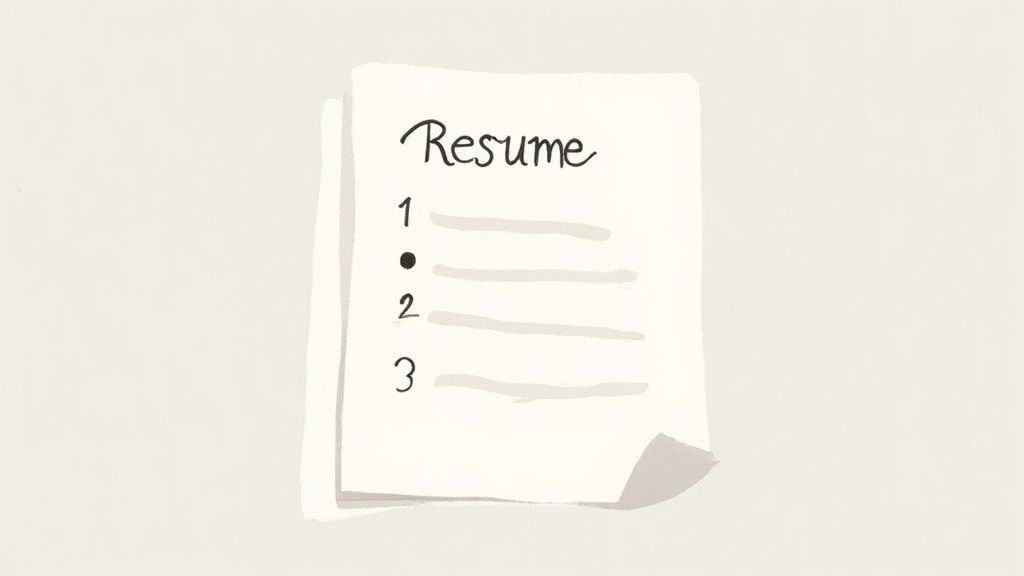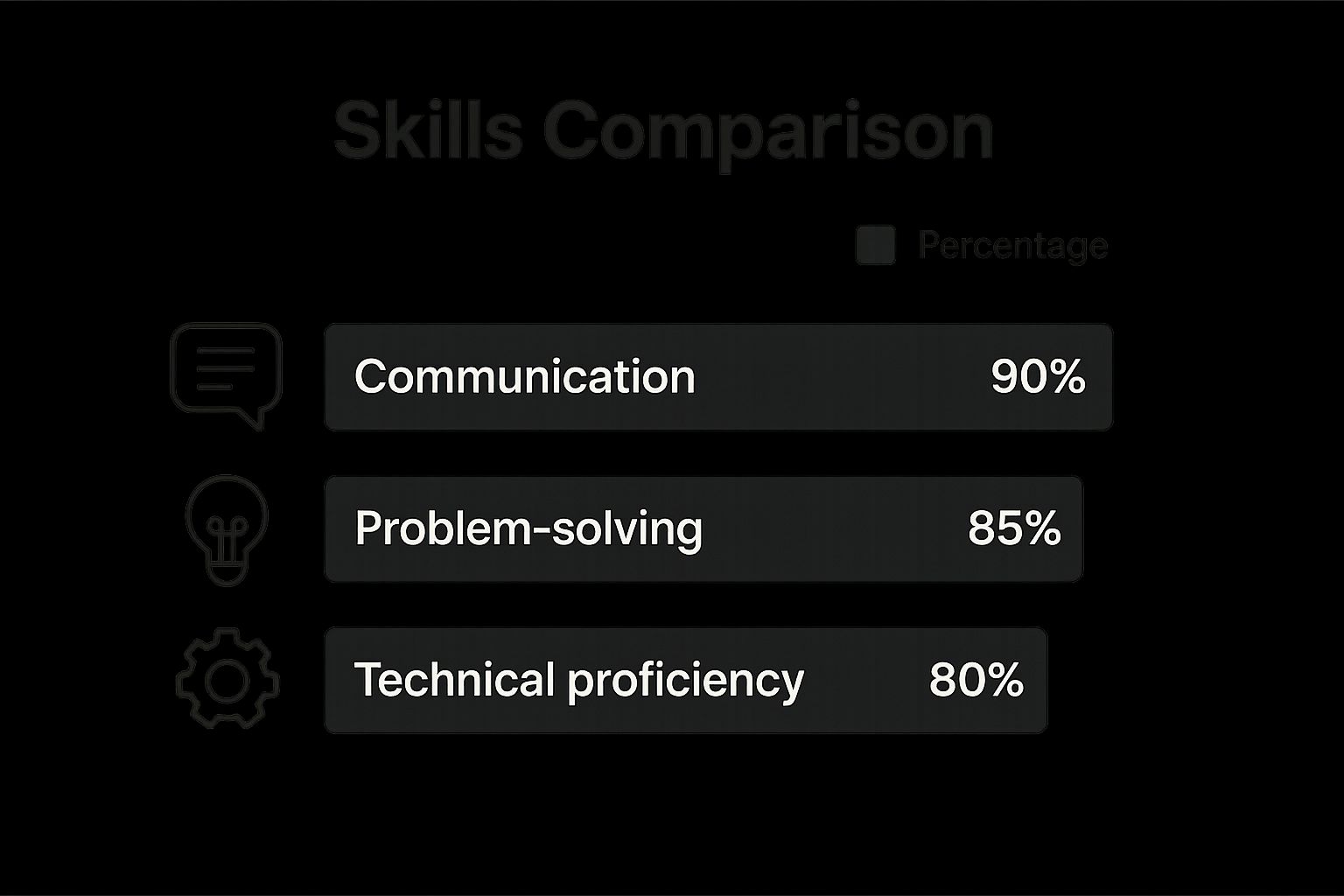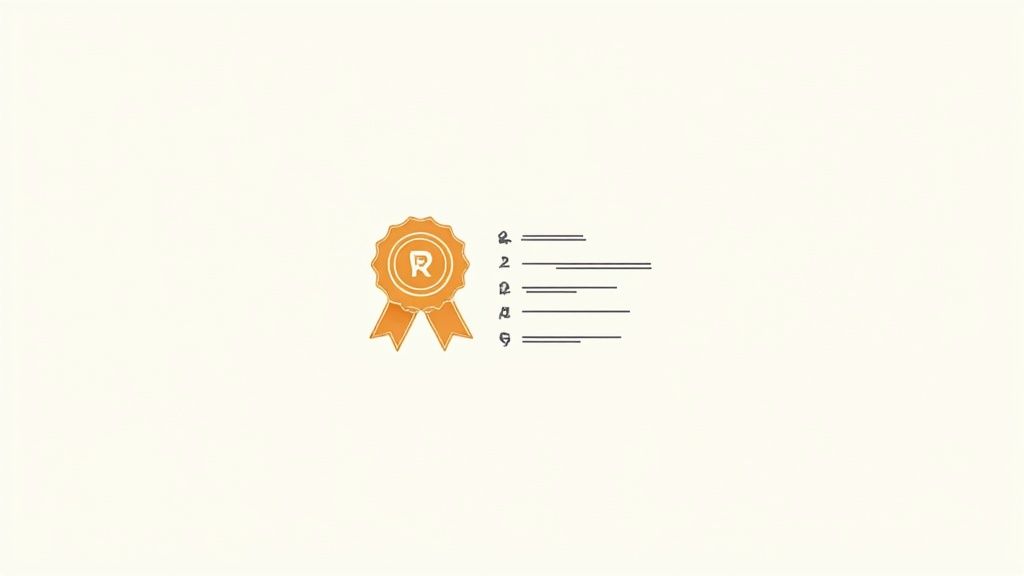
What Employers Look For in Resumes A Guide
When you’re applying for a job, what are employers really looking for? At its core, they want a resume that’s clear, relevant, and packed with achievements. It needs to be a breeze to read, customized for the job you want, and show what you’ve actually accomplished—not just what you were told to do.
Passing the Six-Second Resume Test
Picture a recruiter staring at a mountain of applications for just one open position. This is the reality. Your resume gets a tiny window—a mere moment—to grab their attention and convince them you’re worth a closer look.
That first impression is everything, and it happens in the blink of an eye. Most hiring managers only spend 6 to 8 seconds on their initial scan. If your resume makes the cut, they might circle back for a deeper read, but that first glance is brutal. In fact, a shocking 73% of resumes get tossed out right away simply because of bad formatting. This tells you that a clean, professional look isn’t just a nice-to-have; it’s a ticket to the next round.
What Catches a Recruiter’s Eye
In that fleeting six-second window, a recruiter’s brain is on a mission. They aren’t reading your life story; they’re scanning for specific signposts that scream “good fit.” This is why a clean, logical layout is your secret weapon.
Think of your resume as a movie trailer. It needs to be exciting enough to make the hiring manager want to see the full feature film—which is your interview.
So, what are they scanning for?
- Your Name and Contact Info: Is it obvious and professional?
- Current Role and Company: Is your most recent experience relevant?
- Previous Roles and Companies: Can they quickly trace your career path?
- Start and End Dates: Are there any glaring, unexplained gaps in your work history?
- Keywords and Skills: Does your resume echo the language used in the job description?
If a recruiter has to hunt for this basic information in a dense wall of text or a messy design, they’ll move on. Your resume is out.
This is where a quick summary table can help you visualize what’s most important.
The Six-Second Scan Checklist
Here’s a quick breakdown of what a recruiter is trying to confirm in that initial, high-speed review. Think of it as your pre-flight checklist before hitting “submit.”
| Resume Element | What Recruiters Look For | Why It Matters |
|---|---|---|
| Contact Info | Is it easy to find and professional? | They need to know who you are and how to reach you instantly. |
| Current Role | Does your title and company align with the job? | It’s the fastest way to gauge relevance and experience level. |
| Career Path | Is there a logical progression in your roles? | It shows growth, ambition, and stability. |
| Key Dates | Are there major, unexplained employment gaps? | Long gaps can be a red flag that needs context. |
| Keywords | Are there specific skills/terms from the job ad? | This signals an immediate match for the role’s core needs. |
| Readability | Is the layout clean, with clear headings? | A cluttered resume is an unreadable resume. |
Making sure these elements are front and center is your best strategy.
A strong professional summary right at the top can also act as a powerful hook, immediately telling the recruiter who you are and the value you bring. For more tips on this, our guide on what makes a resume stand out dives deeper into crafting a document that gets noticed.
By focusing on scannability and immediate impact, you give your resume the best possible chance of surviving that critical first cut and earning the closer look it deserves.
Winning Over the Resume Robots

Before a real person—a hiring manager, a recruiter—ever lays eyes on your resume, it has to get past a digital gatekeeper. This gatekeeper is the Applicant Tracking System, or ATS.
Think of an ATS as a company’s first line of defense against the mountain of applications they receive. It’s a piece of software that scans, sorts, and ranks every resume based on how well it matches the job description. Its goal is speed and efficiency, not understanding the subtle nuances of your career story.
And these systems are everywhere. A mind-boggling 99% of Fortune 500 companies use an ATS, and smaller businesses are quickly catching on. This means your first audience isn’t human. So, learning what employers look for starts with learning how to get past their robots. It’s not an obstacle to fear; it’s a code you can crack.
Speak the Right Language with Keywords
The ATS is essentially a matching game. It scans your resume for specific keywords and phrases pulled directly from the job posting. If your resume contains enough of the right terms, you get a high score and move on. If not, you’re screened out.
Your mission is to find those keywords. Start by dissecting the job description you’re applying for. Look for the core responsibilities, qualifications, and skills they mention over and over. Pay attention to both the hard skills (like “Python,” “SEO analysis,” or “QuickBooks”) and the soft skills (“team leadership,” “client communication”).
Your resume should be a mirror, reflecting the exact language the employer uses. If they ask for a “content strategist,” your resume had better say “content strategist”—not “brand journalist” or “word wizard.”
For example, imagine a job description lists these must-haves:
- Proficiency with Salesforce CRM
- Demonstrated success in lead generation
- Excellent negotiation skills
You need to make sure those exact phrases appear somewhere in your resume, ideally woven into your work experience bullet points. A generic resume that just says “CRM experience” will get a lower score than one that explicitly names “Salesforce CRM.”
Keep Your Formatting Simple and Clean
I get it—you want your resume to stand out. A fancy design with cool fonts and columns can feel impressive. But to an ATS, it’s just gibberish. These systems are built for simplicity, and complex formatting can trip them up, making your perfectly good experience completely unreadable.
To make sure the robot can actually read your resume, stick to these rules:
- Use Standard Fonts: Don’t get creative here. Stick with classics like Arial, Calibri, or Times New Roman.
- Ditch Tables and Columns: An ATS reads a document from left to right, top to bottom. If you use columns, it might mash the text from both columns together into one nonsensical sentence.
- Label Sections Clearly: Use straightforward headings like “Work Experience,” “Education,” and “Skills.” Now is not the time for clever titles like “Where I’ve Been” or “My Superpowers.”
- Choose the Right File Type: Unless the job posting says otherwise, a .docx file is often the safest bet. PDFs are great for preserving your layout for human eyes, but some older ATS versions still struggle to parse them correctly.
Getting your resume past the ATS is the critical first step in any modern job search. To take the guesswork out of it, starting with an ATS-friendly resume template gives you a solid foundation and lets you focus on what really matters: showcasing your skills and achievements.
Showcasing Your Achievements, Not Just Your Duties

So, your resume made it past the bots. Great. Now it’s in front of a real person, and this is where the real test begins. Far too many people stumble here by making a simple mistake: they just list their job duties. Your resume ends up reading like a generic job description, telling a hiring manager what you were supposed to do, but not how well you actually did it.
Think about it this way. A chef’s job description might say “cooks food.” But what a restaurant owner really wants to know is whether that chef created dishes that got five-star reviews and had customers lining up around the block. Employers don’t hire you to just check off tasks; they hire you to make an impact. This shift in mindset is the single most important change you can make to your resume.
This isn’t just a hunch—it’s backed by data. A recent report found that almost two-thirds of employers are now focused on skills-based hiring, looking for solid proof that a candidate can deliver. In fact, fewer than 40% of employers even screen candidates by GPA anymore. They care more about what you can do than what you studied.
From Vague Duties to Concrete Wins
Turning a dull responsibility into a compelling achievement is all about changing your perspective. Instead of just stating the task, you need to explain the outcome. The magic ingredient? Numbers. Quantifying your results gives a hiring manager hard evidence of the value you bring to the table.
Let’s look at a quick before-and-after for a marketing role to see what I mean:
- Before (Duty): “Managed the company’s social media accounts.”
- After (Achievement): “Grew social media engagement by 40% in six months by launching a new content strategy based on audience analytics.”
See the difference? The first one is passive and could describe anyone. The second is active, specific, and tells a story of success. It immediately answers the questions every recruiter has: What was the result? and How did you achieve it?
Using a Simple Framework for Impact
A fantastic tool for crafting these achievement-focused bullet points is the STAR method. It’s a simple framework that helps you structure your accomplishments in a way that truly demonstrates your impact.
Here’s how it breaks down:
- Situation: What was the context or challenge you were facing?
- Task: What was your specific goal or responsibility?
- Action: What exact steps did you take to tackle the task?
- Result: What was the positive, measurable outcome of your actions?
On a resume, you don’t need to spell out each step. Instead, you blend them into one powerful statement that tells the whole story.
“Increased team productivity by 25% by implementing a new project management software (Action) that automated repetitive tasks and improved cross-departmental communication (Result).”
A single bullet point like that shows you can identify a problem, take initiative, and deliver tangible improvements for the business. When you consistently frame your experience this way, you’re giving a hiring manager exactly what they’re looking for. You can find more strategies like this in our guide to the most effective resume writing tips.
By focusing on what you accomplished, you change the entire narrative. You’re no longer just someone who did a job; you’re someone who created real, measurable value. And that’s what gets you the interview.
Structuring Your Resume for Maximum Impact
Think of your resume’s structure as its skeleton. It holds everything together and guides a recruiter through your professional story. If the layout is confusing, your best qualifications get lost. But with a clear, logical flow, your value becomes obvious in seconds. The whole point is to build a persuasive argument for why you’re the right person for the job.
You want to create a reading experience that’s completely seamless. A hiring manager’s eyes should naturally follow a path that highlights your biggest wins and most relevant skills. This all starts with choosing the right format and then arranging each section to tell a compelling story.
Choosing Your Resume Format
The format you pick really depends on your career stage and what you’re trying to achieve. There’s no single “best” option; the right choice is the one that frames your experience in the most flattering way. Each format tells a slightly different version of your professional story.
The three most common formats are:
- Reverse-Chronological: This is the industry standard for a reason. It lists your work history from your current or most recent job backward. It’s perfect if you have a steady, progressing career path without major gaps.
- Functional: This one puts your skills front and center, pushing your work history to the background. It’s a strategic choice for career changers, recent grads, or anyone with significant employment gaps because it focuses on what you can do rather than where you’ve worked.
- Combination (Hybrid): Just like it sounds, this format blends the best of both worlds. It usually kicks off with a detailed skills summary followed by a chronological work history, giving recruiters a solid look at both your capabilities and your career progression.
To help you decide, here’s a quick breakdown of the three main resume formats and when to use them.
| Format Type | Best For | When to Avoid |
|---|---|---|
| Chronological | Candidates with a strong, linear career path and consistent employment history. | If you have significant gaps in your work history or are changing careers. |
| Functional | Career changers, recent graduates, or individuals with employment gaps. | If you want to highlight career growth or promotions within specific companies. |
| Combination | Experienced professionals with a diverse skill set who want to showcase both skills and experience. | Entry-level candidates who may not have enough experience to fill out both sections robustly. |
Ultimately, picking a format is about strategy. You’re choosing the layout that will best sell your unique experience to a busy recruiter.
Your resume’s structure should act like a skilled tour guide, pointing out the most impressive landmarks of your career without getting lost in the details. The format you choose sets the itinerary for that tour.
Essential Components Employers Expect
Once you’ve settled on a format, every resume needs a few non-negotiable sections. These are the building blocks that recruiters and hiring managers scan for immediately to get a quick sense of who you are and whether you’re a potential fit. Missing any of these can make your resume feel incomplete or, worse, make it hard for them to find what they’re looking for.
Aside from your name and contact info, these are the core components:
- Professional Summary: This is your 2-3 sentence “elevator pitch” right at the top. It should quickly summarize your key experience, top skills, and what you’re looking to do next.
- Skills Section: A dedicated spot to list your most relevant hard and soft skills. This is prime real estate for matching the keywords you found in the job description.
- Work Experience: This is the heart of your resume. Here, you’ll detail your previous roles, but the key is to focus on quantifiable achievements, not just a boring list of daily duties.
The image below really drives home why these sections matter, showing exactly what skills employers are looking for.

As you can see, soft skills like communication and problem-solving are just as important to employers as technical know-how. This is why having a well-organized skills section is so critical. By putting these key elements together in a logical format, you create a powerful document that’s easy to scan and hard to forget.
Customizing Your Resume for Each Job You Apply For
Think about it this way: sending the same resume out for every single job application is like using a master key on a dozen different locks. It just doesn’t work. Hiring managers aren’t just looking for someone who can do the job; they’re looking for the person who is excited about their company and this specific role. A customized resume is your way of showing you’ve done your homework and you see yourself as the perfect fit for their team.
This approach isn’t just a nice-to-have, it’s essential. The job market is incredibly competitive. On average, only about 3% of applicants even make it to the interview stage. That number tells you just how ruthless the filtering process is. To get noticed, your resume needs to feel like it was written specifically for the person reading it. If you’re curious about how employers trim down their applicant pool, you can get a behind-the-scenes look at the data in this analysis of recruiting metrics and KPIs.
Dissecting the Job Description
The job description is your secret weapon. It’s basically a cheat sheet that spells out exactly what the company wants. Before you write a single word, your first step should be to break that description down. Read it slowly, and highlight the skills, qualifications, and key responsibilities they mention over and over.
Pay special attention to the exact words they use. If the posting asks for “project management experience,” make sure that exact phrase is somewhere in your resume. If they list “client relationship building” as a core duty, you’ll want to mirror that language in your experience section. This isn’t just about sounding like a good fit; it helps your resume get past the automated Applicant Tracking Systems (ATS) and immediately signals to a human reader that you’re on the same page.
Your resume should never be a static document. Think of it as a master template—a block of clay you can reshape and refine for every single application you submit.
A Practical Workflow for Customization
Now, this doesn’t mean you need to write a brand-new resume from scratch every time. That would be exhausting and completely unsustainable. The trick is to have a “master resume” that contains everything you’ve ever done—all your experiences, skills, projects, and wins.
Then, for each job you apply for, you just need to trim and adjust it. Here’s a simple workflow that works every time:
- Analyze the Job Posting: Pull out 5-7 of the most important requirements and keywords. What are the absolute must-haves for this role?
- Adjust Your Summary: Rewrite your professional summary or objective at the top. Make it a direct answer to the company’s biggest needs for this position.
- Refine Your Bullet Points: Tweak the bullet points under your work experience. Rephrase your achievements to highlight the results that matter most for this new job. If the role is heavy on data analysis, bring the bullet points that show off your data skills to the forefront.
- Curate Your Skills Section: Reorder your skills list. The most important skills from the job description should be right at the top, easy to find.
Putting in this little bit of extra effort makes your resume speak directly to the hiring manager. It shows them you’re not just spraying and praying—you’re genuinely interested in this job.
Avoiding Common Resume Mistakes

You’ve spent hours crafting the perfect resume—structuring it, tailoring your experience, and highlighting your biggest wins. But all that hard work can be undone in an instant by a simple, avoidable error. It’s a harsh reality, but even the most qualified people get passed over because of small mistakes that scream “lack of attention to detail.”
Think of this final review as your last line of defense. A single typo can be all it takes for a hiring manager to move on to the next candidate. The same goes for an old, unprofessional email address (I’m looking at you, [email protected]). These seemingly minor details add up, shaping a recruiter’s first impression before they even get to your impressive work history.
Your Final Quality Checklist
Before you even think about hitting “send,” go through this quick checklist. These are the most frequent blunders that drive hiring managers crazy and can easily cost you a shot at an interview.
- Proofread Like a Pro: Read it. Then read it again, but backward this time—it forces your brain to focus on each word individually. Better yet, have a trusted friend or colleague give it a once-over for typos, grammar slip-ups, or clunky sentences you might have missed.
- Double-Check Your Contact Info: Is your phone number correct? Is your email address professional and spelled right? Make sure it’s impossible for them to not know how to reach you.
- Give Your File a Professional Name: Save your resume as something clean and easy to identify, like
FirstName-LastName-Resume.pdf. A file namedresume_final_v2.docxjust looks messy. - Always Send a PDF: Unless the job posting specifically requests a different format, a PDF is the gold standard. It locks in your formatting, so it looks exactly the way you designed it on any computer or phone.
A resume with typos is like showing up to an interview with a coffee stain on your shirt. It suggests you don’t care about the details, and it distracts from all the great things you have to offer.
Trimming the Unnecessary Fat
What you choose to leave out of your resume is just as important as what you put in. Too many people cram their resumes with outdated or irrelevant information, which only buries their most compelling qualifications.
Keep your resume sharp, focused, and powerful by cutting these common space-wasters:
- Irrelevant Hobbies: No one needs to know you enjoy hiking unless you’re applying to be a park ranger. If a hobby doesn’t directly support your candidacy (like a coding side project for a developer role), leave it off.
- Empty Buzzwords: Phrases like “synergy,” “go-getter,” and “results-driven” are so overused they’ve become meaningless. Instead of telling them you’re results-driven, show them with concrete, quantified achievements.
- Personal Information: In most countries, including a photo, your age, or marital status is unnecessary and can even introduce unconscious bias. Stick to your professional qualifications.
By sidestepping these common pitfalls, you let your skills and accomplishments do the talking, ensuring nothing gets in the way of you landing that interview.
Got Questions? Let’s Talk Resumes.
Even after you’ve polished every bullet point, a few lingering questions can pop up. Let’s tackle some of the most common ones I hear from job seekers so you can send off that application feeling totally confident.
So, How Long Should a Resume Really Be?
Ah, the age-old “one-page rule.” It’s a solid starting point, but it’s not a law. Honestly, what recruiters and hiring managers care about is relevance and impact—not whether you hit a specific page count. The best way to figure out your ideal length is to look at your own career stage.
- Just Starting Out (0-5 years): Stick to one page. Be ruthless. Your goal is to showcase your most potent internships, academic projects, and relevant skills in a tight, focused document.
- Established Professional (5-15 years): One to two pages is perfectly fine. You’ve earned the space. Concentrate on your most significant roles and achievements from the last 10-15 years.
- Senior Leader or Expert (15+ years): A two-page resume is the norm. If you’re in a highly specialized field like academia or science, a third page might even be necessary to list things like publications, patents, or extensive project portfolios.
Is an “Optional” Cover Letter Actually Optional?
When you see “cover letter optional,” what should you do? My advice is almost always the same: write it. Think of it this way—it’s a golden opportunity to get a leg up on everyone else who decided to skip it.
A resume gives them the “what,” but a cover letter provides the “why.” It’s your chance to tell a story, show your genuine excitement for the job, and draw a direct line between your experience and what the company is trying to achieve.
A cover letter is your strategic advantage. While other candidates are just submitting a dry list of facts, you’re providing a compelling narrative that makes a hiring manager actually want to meet you.
What Do I Do About a Gap in My Employment History?
First off, take a breath. Employment gaps happen. Life happens. Recruiters and employers get it, and these gaps are far more common than people think. The trick is to handle them with confidence, not try to hide them.
Instead of leaving a mysterious void on your timeline, address it head-on. You can frame it as a productive period. For instance, you could add an entry like “Professional Development” or “Sabbatical for Family Care” with the corresponding dates. Then, add a quick bullet point about a skill you learned, a certification you earned, or a project you tackled during that time. The goal is to show you were still growing and engaged.
Ready to stop worrying about formatting and start landing interviews? Jobcamp uses AI to instantly create customized, ATS-friendly resumes and cover letters for every job you apply for. Stop guessing what employers want and start building documents that get results. Try it for free at https://www.jobcamp.ai.

